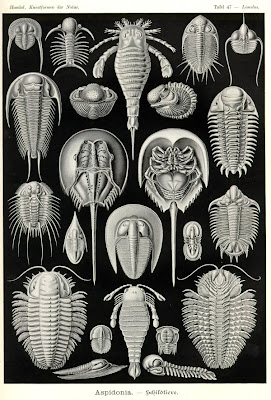
I came across these plates from Ernst Haeckel: Kunstformen der Natur 1899-1904 a couple of weeks ago on a needlework design Web site. I was so pleased to find them I thought I'd post the link here, and add a few other Ernst Haeckel links for good measure. As I searched for sensible, informative Haeckel links, I was amazed at the large number of Web sites offering vitriolic attacks on the man and his work. I would not have expected a comparative invertebrate anatomist who died in 1919 to elicit so much venom, let alone interest. I found creationists denouncing him, biologists calling him "forger" and "fraud," and even Lenin offers a scathing critique, courtesy of Marxists.org.
Haeckel coined the terms "ecology" and "first world war," and he pioneered embryology and marine biology. His drawings and colored plates are breathtaking. Do check out Art Forms in Nature. The plate above, featuring trilobites, eurypterids and horseshoe crabs is plate 47 from this volume. I understand why creationists don't like him, because he was a proponent of evolution, but I'm not sure why biologists are so vexed that he was wrong about some stuff. Darwin was wrong about lots of things too, but I've observed a cult-like devotion to Darwin among some biologists. (Alfred Wallace is my personal favorite, but then, I like insect collecting and biogeography.)
Here are some of the more balanced accounts of Haeckel. In my opinion, researchers always present the data that best support their ideas. This isn't "fraud," (although sometimes it stretches facts far enough to be called "spin,") and it's necessary to get your papers published and your grant proposals funded. Several of these Web authors feel the need to apologize for Haeckel's inaccuracies, but I don't think it's necessary myself.
- Biography of Haeckel from University of California Museum of Paleontology
- Ernst Haeckel: Artforms in Nature Exhibit from the Marine Biology Lab of Woods Hole Oceanographic Institute Library. These science librarians seem to feel the need to justify their Haeckel exhibition:
His watercolors and drawings, made during his sojourn in Ceylon (Travel Pictures) and on his scientific journeys (Art Forms in Nature), are landmarks in the field of naturalist illustration, although many would not pass strict scientific muster. Indeed, much of naturalist illustration is not natural at all but permits stylization and distortion for decorative effect. Haeckel aimed Art Forms in Nature at a broad audience rather than specialists. Each of the 100 plates was accompanied by a short, readable commentary that made biological concepts accessible to the public. Moreover Haeckel's use of Art Nouveau techniques made the book even more appealing and "fashionable." The publication was an immediate success and remains a treasure to this day.
- Ernst Haeckel: Evolution's controversial artist--an unnecessarily apologetic but interesting slide show from Slate.com, 2005.
- Wikipedia article on Ernst Haeckel
- Early Evolution and Development: Ernst Haeckel from Understanding Evolution
2 comments:
Haeckel made a few mistakes over a century ago and the ID/Creationist crowd still cite his work as anti-evolutionary evidence.
Haeckel is outside the mainstream of biological science these days. His real significance is the enduring appeal of his artwork. I've had a Dover paperback edition of Artforms In Nature for many years, but recently I've been enjoying the high-resolution images of the plates from the book which are available from Wikipedia. They print out nicely and make wonderful frameable prints.
I realize that Haeckle took some liberties, arranging tentacles gracefully and suchlike, but I still love the images.
Haeckel's "nuts and bolts" science was his marine invertebrate embryology, and it's still solid. It's not as "exciting" as "ontogeny recapitulates phylogeny" but I think much of that "armchair biology," where the prominent scientist sits back and speculates on the Nature of Things goes by the wayside after a decade or two.
Gotta love those plates, though.
Post a Comment